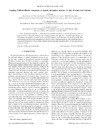Identificador persistente para citar o vincular este elemento:
https://accedacris.ulpgc.es/jspui/handle/10553/47998
| Campo DC | Valor | idioma |
|---|---|---|
| dc.contributor.author | Florido, R | en_US |
| dc.contributor.author | Martin-Gonzalez, JM | en_US |
| dc.contributor.author | Gomez Llorente, J. M. | en_US |
| dc.contributor.other | Gomez Llorente, Jose | - |
| dc.contributor.other | Martin Gonzalez, Juan Manuel | - |
| dc.contributor.other | Florido, Ricardo | - |
| dc.date.accessioned | 2018-11-23T18:09:02Z | - |
| dc.date.available | 2018-11-23T18:09:02Z | - |
| dc.date.issued | 2002 | en_US |
| dc.identifier.issn | 1539-3755 | en_US |
| dc.identifier.uri | https://accedacris.ulpgc.es/handle/10553/47998 | - |
| dc.description.abstract | A class of numerical methods to determine Pollicott-Ruelle resonances in chaotic dynamical systems is proposed. This is achieved by relating some existing procedures which make use of Pade approximants and interpolating exponentials to both the memory function techniques used in the theory of relaxation and the filter diagonalization method used in the harmonic inversion of time correlation functions. This relationship leads to a theoretical framework in which all these methods become equivalent and which allows for new and improved numerical schemes. | en_US |
| dc.language | eng | en_US |
| dc.publisher | 1063-651X | |
| dc.relation.ispartof | Physical Review E - Statistical, Nonlinear, and Soft Matter Physics | en_US |
| dc.source | Physical Review E [ISSN 1539-3755], v. 66 (4) | en_US |
| dc.subject | 22 Física | en_US |
| dc.subject.other | Axiom-A Flows | |
| dc.subject.other | Filter-Diagonalization | |
| dc.subject.other | Harmonic Inversion | |
| dc.subject.other | Quantum | |
| dc.subject.other | Spectra | |
| dc.subject.other | Rates | |
| dc.subject.other | Maps | |
| dc.title | Locating Pollicott-Ruelle resonances in chaotic dynamical systems: A class of numerical schemes | en_US |
| dc.type | info:eu-repo/semantics/Article | es |
| dc.type | Article | es |
| dc.identifier.doi | 10.1103/PhysRevE.66.046208 | |
| dc.identifier.scopus | 37649033113 | - |
| dc.identifier.isi | 000179176300059 | - |
| dcterms.isPartOf | Physical Review E | |
| dcterms.source | Physical Review E[ISSN 1539-3755],v. 66 (4) | |
| dc.contributor.authorscopusid | 6505795084 | - |
| dc.contributor.authorscopusid | 6603384846 | - |
| dc.contributor.authorscopusid | 6603427722 | - |
| dc.description.lastpage | 10 | - |
| dc.description.firstpage | 10 | - |
| dc.relation.volume | 66 | - |
| dc.investigacion | Ciencias | en_US |
| dc.type2 | Artículo | en_US |
| dc.contributor.daisngid | 835287 | - |
| dc.contributor.daisngid | 1769703 | - |
| dc.contributor.daisngid | 520043 | - |
| dc.identifier.investigatorRID | F-9947-2016 | - |
| dc.identifier.investigatorRID | H-6127-2015 | - |
| dc.identifier.investigatorRID | H-5513-2015 | - |
| dc.utils.revision | Sí | en_US |
| dc.contributor.wosstandard | WOS:Florido, R | |
| dc.contributor.wosstandard | WOS:Martin-Gonzalez, JM | |
| dc.contributor.wosstandard | WOS:Llorente, JMG | |
| dc.date.coverdate | Octubre 2002 | |
| dc.identifier.ulpgc | Sí | es |
| item.grantfulltext | open | - |
| item.fulltext | Con texto completo | - |
| crisitem.author.dept | GIR IUNAT: Interacción Radiación-Materia | - |
| crisitem.author.dept | IU de Estudios Ambientales y Recursos Naturales | - |
| crisitem.author.dept | Departamento de Física | - |
| crisitem.author.orcid | 0000-0001-7428-6273 | - |
| crisitem.author.orcid | 0000-0003-0096-7142 | - |
| crisitem.author.parentorg | IU de Estudios Ambientales y Recursos Naturales | - |
| crisitem.author.fullName | Florido Hernández, Ricardo Jesús | - |
| crisitem.author.fullName | Martín González, Juan Manuel | - |
| Colección: | Artículos | |
Citas SCOPUSTM
9
actualizado el 08-jun-2025
Citas de WEB OF SCIENCETM
Citations
8
actualizado el 08-jun-2025
Visitas
166
actualizado el 27-sep-2025
Descargas
208
actualizado el 27-sep-2025
Google ScholarTM
Verifica
Altmetric
Comparte
Exporta metadatos
Los elementos en ULPGC accedaCRIS están protegidos por derechos de autor con todos los derechos reservados, a menos que se indique lo contrario.
